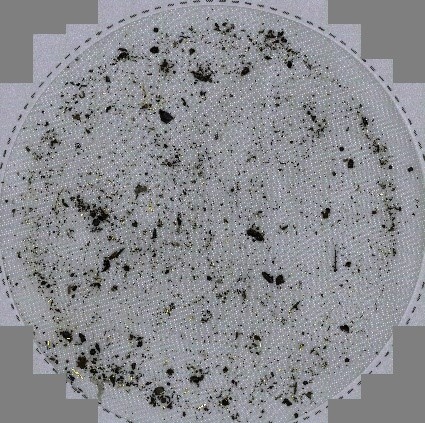Testing technical cleanliness: Overlaying analysis filters - What to do?
In technical cleanliness, particle residues are removed from the component by extraction and separated on analysis filters by analysis filtration to test component cleanliness. If overlaying of the analysis filter occurs during analysis filtration, this can have negative effects on the microscopic evaluation, up to and including non-evaluability. This article discusses the causes and measures to be taken in the event of analysis filter overlay.
What are analysis filter overlays and what are possible causes?
A filter overlay occurs when particles on a filter are so close together that they can no longer be clearly distinguished from one another and separate optical detection is no longer possible. This can significantly impair the accuracy of the particle analysis or even make it impossible. Mesh filters show increasing difficulties in light-optical analysis from an occupancy density of approx. 3 %, foamed membranes from approx. 1.5 %.
Possible causes of filter overlay:
- High particle load: If the particle load on the test specimen is very high, overlay may occur on the filter.
- Filter mesh size too small: If the filter mesh size is too small, the particles may not be sufficiently separated.
- Uneven particle distribution: An uneven distribution of particles on the filter can also lead to overlaying.
- Unsuitable extraction method or medium: An overlay can also indicate that the extraction medium or extraction method is too aggressive for the component. A visual inspection, possibly under a microscope, can confirm this suspicion if many uniform particles of the same material are found on the analysis filter
Possible measures against superimposed analysis filters
- Check cleanliness specification:
- Check whether the cleanliness specification for the component should be adapted to the production-related cleanliness condition and damage potential.
- Adapt the cleanliness specification based on the specific requirements of the component and the application.
- Optimize extraction method or medium:
- If the suspected detachment of particles from the component material is confirmed (e.g. ultrasound for cast components), the extraction method must be adapted
- Repeat the qualification test with adapted parameters.
- Prioritize the most important particle sizes and particle types:
- Based on the review of the limit values, the focus should be placed on the critical particles with high damage potential.
- Identify the particle sizes and types that have the greatest impact on the functionality of the component.
- Determine filter mesh size and number of filters (cascade):
- Selection of the appropriate filter mesh size based on the limit values and the particle focus.
- Determination of the possible number of filters for a filter cascade.
- Individual filters are analyzed microscopically and evaluated in summary. Additional costs are incurred for the individual microscopic evaluations.
- Rearrangement and microscopic evaluation:
- If there is still an overlay, the particles can be rearranged on individual filters with different mesh sizes using a filter cascade.
- The analysis filters are individually analyzed microscopically and evaluated in summary. Additional costs are incurred for the rearrangement and microscopic analysis, which must be taken into account.
- Gravimetric evaluation:
- Gravimetric evaluation is the last possible measure if the previously mentioned measures are neither effective nor economical or the analysis filter is completely occupied. This means that at least the residue weight of the particles provides an indication of the general degree of contamination of the components.
Conclusion
Die Überlagerung von Analysefiltern stellt eine Herausforderung in der Prüfung der Technischen Sauberkeit dar. Durch die gezielte The overlapping of analysis filters poses a challenge in technical cleanliness testing. The accuracy of particle analysis can be improved by specifically checking limit values, prioritizing the most important particles, selecting the appropriate filter mesh size and determining the optimum number of filters. The rearrangement and microscopic evaluation offer additional safety and precision in the determination of particle contamination. The economic aspects should also be taken into account. The following measures can be taken to minimize costs:
- Avoidance of excessive particle loads: By reducing the particle loads, the overlay on the filters can be reduced.
- Adapted cleanliness specifications: The specifications should be adapted so that they meet the actual requirements and unnecessary costs are avoided.
- As few filters as possible: The number of filters used should be optimized in order to reduce the costs for microscopic evaluations.
Newsletter registration




